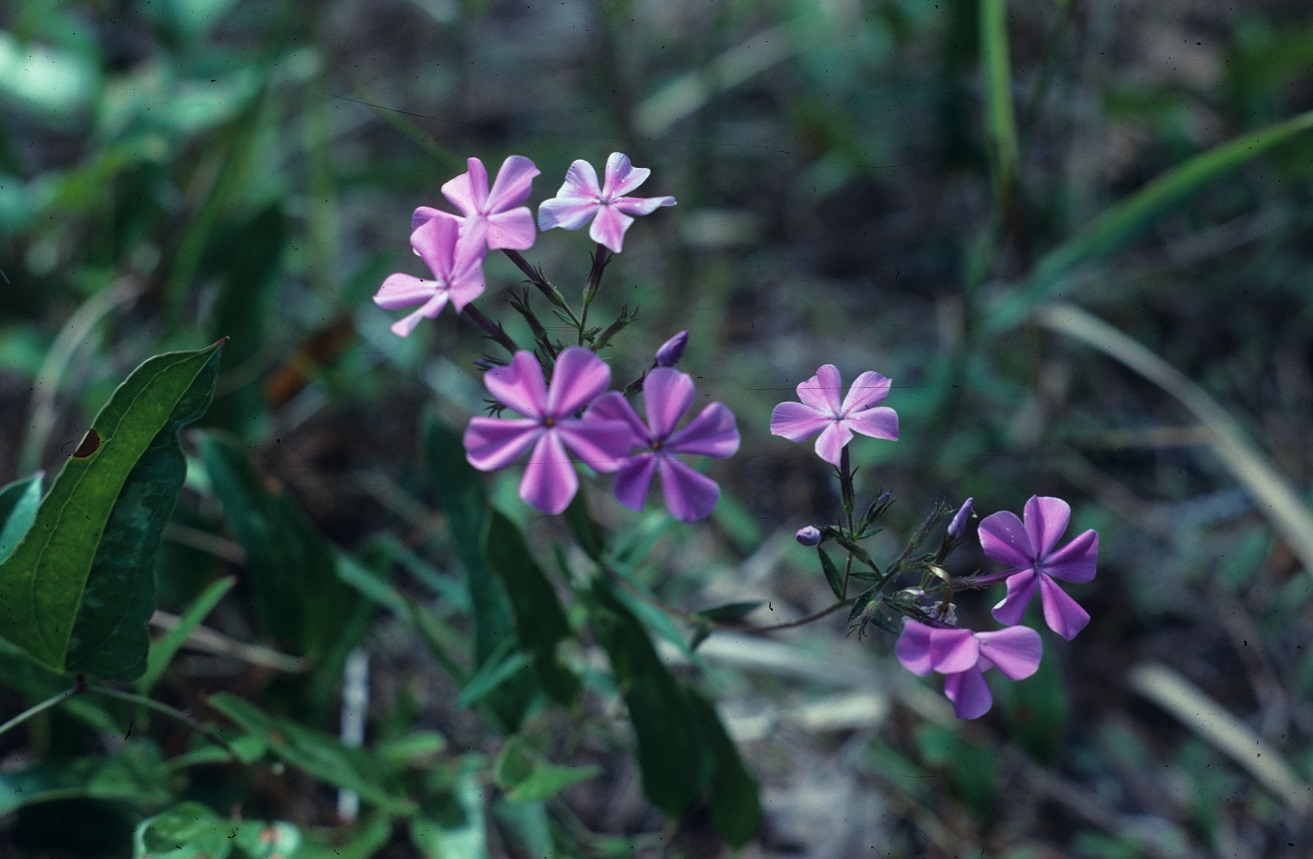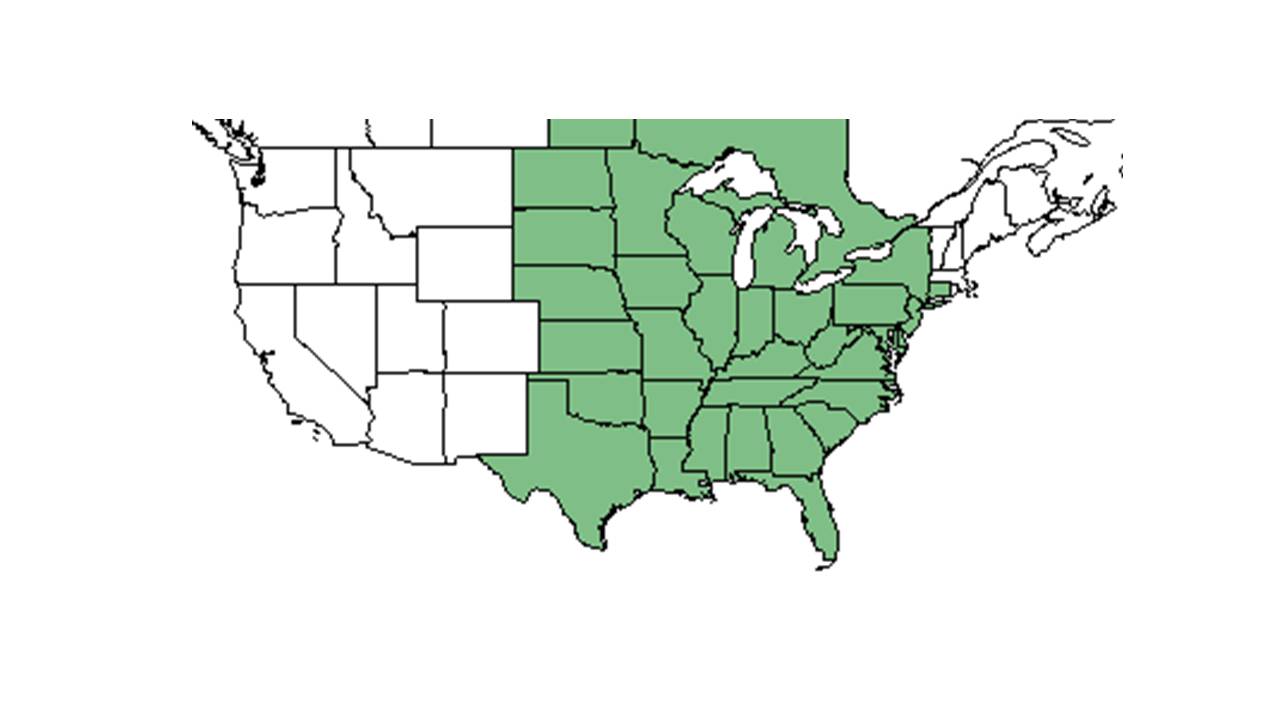Difference between revisions of "Phlox pilosa"
Emmazeitler (talk | contribs) |
(→Distribution) |
||
| (11 intermediate revisions by 5 users not shown) | |||
| Line 18: | Line 18: | ||
}} | }} | ||
| − | Common name: | + | Common name: Deam's phlox, gulf coast phlox, downy phlox, Ozark phlox<ref name=weakley>Weakley, A.S. 2020. Flora of the Southeastern United States. Edition of 20 October 2020. University of North Carolina at Chapel Hill, Chapel Hill, North Carolina.</ref> |
==Taxonomic notes== | ==Taxonomic notes== | ||
| − | Synonyms: | + | Synonyms: ''Phlox pilosa'' var. ''detonsa'' A. Gray<ref name=weakley/> |
| − | Subspecies: ''Phlox pilosa'' Linnaeus ssp. ''deamii'' Levin; ''Phlox pilosa'' Linnaeus ssp. ''detonsa''; ''Phlox pilosa'' Linnaeus ssp. ''ozarkana''; ''Phlox pilosa'' Linnaeus ssp. ''pilosa'' | + | Subspecies: ''Phlox pilosa'' Linnaeus ssp. ''deamii'' Levin; ''Phlox pilosa'' Linnaeus ssp. ''detonsa'' (A. Gray) Wherry; ''Phlox pilosa'' Linnaeus ssp. ''ozarkana''; ''Phlox pilosa'' Linnaeus ssp. ''pilosa''<ref name=weakley/> |
==Description== | ==Description== | ||
| Line 30: | Line 30: | ||
"Slender, erect, flowering stems 2-5 dm tall, often with 2-5 branches from upper nodes, sterile shoots absent or not persistent. Nodes 6-12 on the flowering stems, leaves narrowly lanceolate, the largest 4-8 cm long, 3-8 mm wide, rarely wider, pubescent or glabrate, margins ciliate. Inflorescence open. Calyx 6-12 mm long, the lobes subulate; corolla pink to dark lavender, rarely white, the tube usually pubescent, 11-16 mm long, lobes obovate, 8-12 mm long, apiculate; stamens included; styles cleft ca. ½ their length."<ref name="Radford"/> | "Slender, erect, flowering stems 2-5 dm tall, often with 2-5 branches from upper nodes, sterile shoots absent or not persistent. Nodes 6-12 on the flowering stems, leaves narrowly lanceolate, the largest 4-8 cm long, 3-8 mm wide, rarely wider, pubescent or glabrate, margins ciliate. Inflorescence open. Calyx 6-12 mm long, the lobes subulate; corolla pink to dark lavender, rarely white, the tube usually pubescent, 11-16 mm long, lobes obovate, 8-12 mm long, apiculate; stamens included; styles cleft ca. ½ their length."<ref name="Radford"/> | ||
| − | The subspecies can be distinguished by the qualities of their hairs. The entirety of ''ssp. | + | The subspecies can be distinguished by the qualities of their hairs. The entirety of ''ssp. detonsa'' is glabrous, whereas ''ssp. deamii'' is pubescent and the calyx has long non-glandular hairs with cuspidate and erect tips. ''ssp. pilosa'' has upper stem leaves that are mostly linear, with a more rounded base. The stems have non-glandular hairs toward the base that grade to glandular hairs towards the tip of the stem. Finally, ''spp. ozarkana'' can be identified by the ovate-lanceolate upper stem leaves that are subcordate and broadest at the base. The stems pubescent throughout with glandular hairs.<ref name=weakley/> |
==Distribution== | ==Distribution== | ||
| + | The plant is found throughout the southeast, though the subspecies have varied ranges. ''Ssp. deamii'' ranges from southern Indiana through Kentucky and western Tennessee. ''Ssp. detonsa'' ranges from Panhandle Florida through eastern Texas. ''Ssp. ozarkana'' ranges from Missouri and southeastern Kansas through eastern Oklahoma and Arkansas to northern Louisiana. There are also disjunct populations in central Tennessee. ''Ssp. pilosa'' grows from Pennsylvania to southeastern North Dakota, then south to peninsular Florida and Texas.<ref name=weakley/> | ||
==Ecology== | ==Ecology== | ||
| Line 43: | Line 44: | ||
===Phenology=== <!--Timing off flowering, fruiting, seed dispersal, and environmental triggers. Cite PanFlora website if appropriate: http://www.gilnelson.com/PanFlora/ --> | ===Phenology=== <!--Timing off flowering, fruiting, seed dispersal, and environmental triggers. Cite PanFlora website if appropriate: http://www.gilnelson.com/PanFlora/ --> | ||
| − | ''P. pilosa'' | + | ''P. pilosa'' flowers from April through June with peak inflorescence from April to June.<ref name="FSU Herbarium"/><ref>Nelson, G. [http://www.gilnelson.com/ PanFlora]: Plant data for the eastern United States with emphasis on the Southeastern Coastal Plains, Florida, and the Florida Panhandle. www.gilnelson.com/PanFlora/ Accessed: 12 DEC 2016</ref> |
===Seed dispersal=== | ===Seed dispersal=== | ||
| Line 50: | Line 51: | ||
===Fire ecology=== <!--Fire tolerance, fire dependence, adaptive fire responses--> | ===Fire ecology=== <!--Fire tolerance, fire dependence, adaptive fire responses--> | ||
| − | ''P. pilosa'' shows delayed flowering in response to early-season burning. <ref name="P2011"> Pavlovic, N. B., S. A. Leicht-Young, et al. (2011). "Short-term effects of burn season on flowering phenology of savanna plants." Plant Ecology 212: 611-625.</ref> | + | ''P. pilosa'' shows delayed flowering in response to early-season burning. <ref name="P2011"> Pavlovic, N. B., S. A. Leicht-Young, et al. (2011). "Short-term effects of burn season on flowering phenology of savanna plants." Plant Ecology 212: 611-625.</ref> Populations have been known to persist through repeated annual burning.<ref>Platt, W.J., R. Carter, G. Nelson, W. Baker, S. Hermann, J. Kane, L. Anderson, M. Smith, K. Robertson. 2021. Unpublished species list of Wade Tract old-growth longleaf pine savanna, Thomasville, Georgia.</ref> |
<!--===Pollination===--> | <!--===Pollination===--> | ||
| − | <!--=== | + | <!--===Herbivory and toxicology===--><!--Common herbivores, granivory, insect hosting, poisonous chemicals, allelopathy, etc--> |
<!--===Diseases and parasites===--> | <!--===Diseases and parasites===--> | ||
| − | ==Conservation and | + | ==Conservation, cultivation, and restoration== |
| − | == | + | ==Cultural use== |
==Photo Gallery== | ==Photo Gallery== | ||
<gallery widths=180px> | <gallery widths=180px> | ||
Latest revision as of 10:54, 19 June 2023
| Phlox pilosa | |
|---|---|

| |
| Photo taken by Gil Nelson | |
| Scientific classification | |
| Kingdom: | Plantae |
| Division: | Magnoliophyta - Flowering plants |
| Class: | Magnoliopsida – Dicotyledons |
| Order: | Solanales |
| Family: | Polemoniaceae |
| Genus: | Phlox |
| Species: | P. pilosa |
| Binomial name | |
| Phlox pilosa L. | |

| |
| Natural range of Phlox pilosa from USDA NRCS Plants Database. | |
Common name: Deam's phlox, gulf coast phlox, downy phlox, Ozark phlox[1]
Contents
Taxonomic notes
Synonyms: Phlox pilosa var. detonsa A. Gray[1]
Subspecies: Phlox pilosa Linnaeus ssp. deamii Levin; Phlox pilosa Linnaeus ssp. detonsa (A. Gray) Wherry; Phlox pilosa Linnaeus ssp. ozarkana; Phlox pilosa Linnaeus ssp. pilosa[1]
Description
"Herbaceous or subligneous, short rhizomatous or stoloniferous perennials. Leaves simple, entire, mostly subsessile. Opposite with bases connected by a stipular line or the upper cauline leaves subopposite, rarely alternate. Inflorescence cymose or paniculate-same length as the tube, tube sinuses semi-transparent; corolla salverform, the lobes cuneate or widely or narrowly obovate to suborbicular, apex entire, erose, or notched; anthers unequally inserted near base of corolla tube and included, or at the mouth of the tube and 1 or more usually exserted; styles 3, almost completely fused or appearing cleft or parted. Capsule papery, subglobose or ellipsoid, 4-6 mm long, loculicdial. A genus of considerable horticultural interest and taxonomic difficulty."[2]
"Slender, erect, flowering stems 2-5 dm tall, often with 2-5 branches from upper nodes, sterile shoots absent or not persistent. Nodes 6-12 on the flowering stems, leaves narrowly lanceolate, the largest 4-8 cm long, 3-8 mm wide, rarely wider, pubescent or glabrate, margins ciliate. Inflorescence open. Calyx 6-12 mm long, the lobes subulate; corolla pink to dark lavender, rarely white, the tube usually pubescent, 11-16 mm long, lobes obovate, 8-12 mm long, apiculate; stamens included; styles cleft ca. ½ their length."[2]
The subspecies can be distinguished by the qualities of their hairs. The entirety of ssp. detonsa is glabrous, whereas ssp. deamii is pubescent and the calyx has long non-glandular hairs with cuspidate and erect tips. ssp. pilosa has upper stem leaves that are mostly linear, with a more rounded base. The stems have non-glandular hairs toward the base that grade to glandular hairs towards the tip of the stem. Finally, spp. ozarkana can be identified by the ovate-lanceolate upper stem leaves that are subcordate and broadest at the base. The stems pubescent throughout with glandular hairs.[1]
Distribution
The plant is found throughout the southeast, though the subspecies have varied ranges. Ssp. deamii ranges from southern Indiana through Kentucky and western Tennessee. Ssp. detonsa ranges from Panhandle Florida through eastern Texas. Ssp. ozarkana ranges from Missouri and southeastern Kansas through eastern Oklahoma and Arkansas to northern Louisiana. There are also disjunct populations in central Tennessee. Ssp. pilosa grows from Pennsylvania to southeastern North Dakota, then south to peninsular Florida and Texas.[1]
Ecology
Habitat
Areas P. pilosa can be found include limestone glades, edge of pine-oak woodlands, pine/hardwood areas, semi-boggy slopes of longleaf pine savanna, burned upland longleaf pinelands and in mesic shaded woodlands by streamlet. [3] Has been found to grow in dry loamy sand. [3]
P. pilosa has been found to grow along highways and the remnants of slightly disturbed woodland habitats. [3]
Associated species include Rhynchospora divergens, Sporobolus vaginiflorus, slash pine and longleaf pine. [3]
Phenology
P. pilosa flowers from April through June with peak inflorescence from April to June.[3][4]
Seed dispersal
This species is thought to be dispersed by ants and/or explosive dehiscence. [5]
Fire ecology
P. pilosa shows delayed flowering in response to early-season burning. [6] Populations have been known to persist through repeated annual burning.[7]
Conservation, cultivation, and restoration
Cultural use
Photo Gallery
References and notes
- ↑ 1.0 1.1 1.2 1.3 1.4 Weakley, A.S. 2020. Flora of the Southeastern United States. Edition of 20 October 2020. University of North Carolina at Chapel Hill, Chapel Hill, North Carolina.
- ↑ 2.0 2.1 Radford, Albert E., Harry E. Ahles, and C. Ritchie Bell. Manual of the Vascular Flora of the Carolinas. 1964, 1968. The University of North Carolina Press. 869-870. Print.
- ↑ 3.0 3.1 3.2 3.3 3.4 Florida State University Robert K. Godfrey Herbarium database. URL: http://herbarium.bio.fsu.edu. Last accessed: July 2015. Collectors: Loran C. Anderson, Wilson Baker, Ann F. Johnson, R. A. Norris, Robert K. Godfrey, R. Komarek, T. MacClendon, K. MacClendon. States and Counties: Florida: Calhoun, Gadsden, Hamilton, Jackson, Leon, Wakulla. Georgia: Grady, Thomas. Compiled by Tall Timbers Research Station and Land Conservancy.
- ↑ Nelson, G. PanFlora: Plant data for the eastern United States with emphasis on the Southeastern Coastal Plains, Florida, and the Florida Panhandle. www.gilnelson.com/PanFlora/ Accessed: 12 DEC 2016
- ↑ Kirkman, L. Katherine. Unpublished database of seed dispersal mode of plants found in Coastal Plain longleaf pine-grasslands of the Jones Ecological Research Center, Georgia.
- ↑ Pavlovic, N. B., S. A. Leicht-Young, et al. (2011). "Short-term effects of burn season on flowering phenology of savanna plants." Plant Ecology 212: 611-625.
- ↑ Platt, W.J., R. Carter, G. Nelson, W. Baker, S. Hermann, J. Kane, L. Anderson, M. Smith, K. Robertson. 2021. Unpublished species list of Wade Tract old-growth longleaf pine savanna, Thomasville, Georgia.